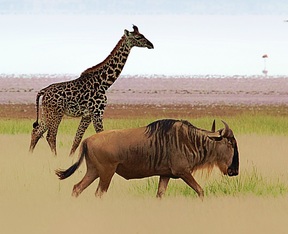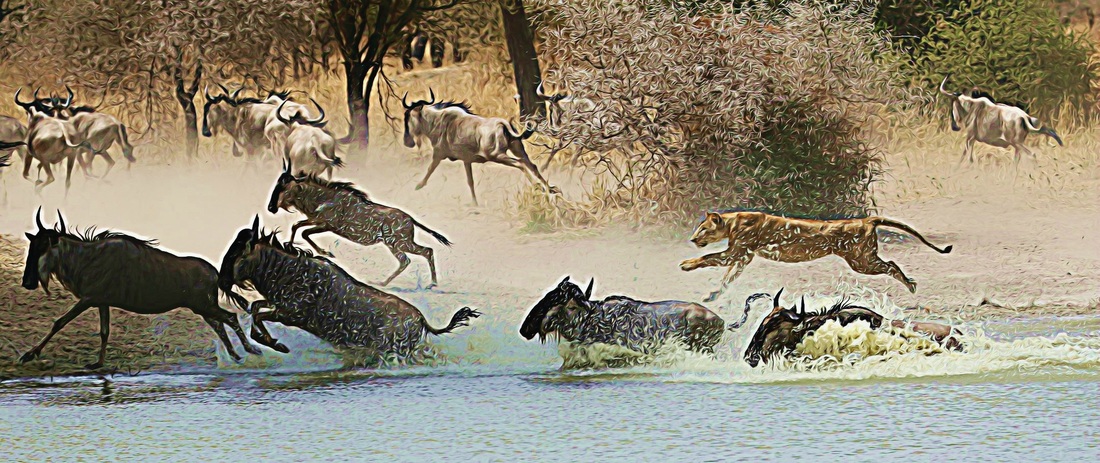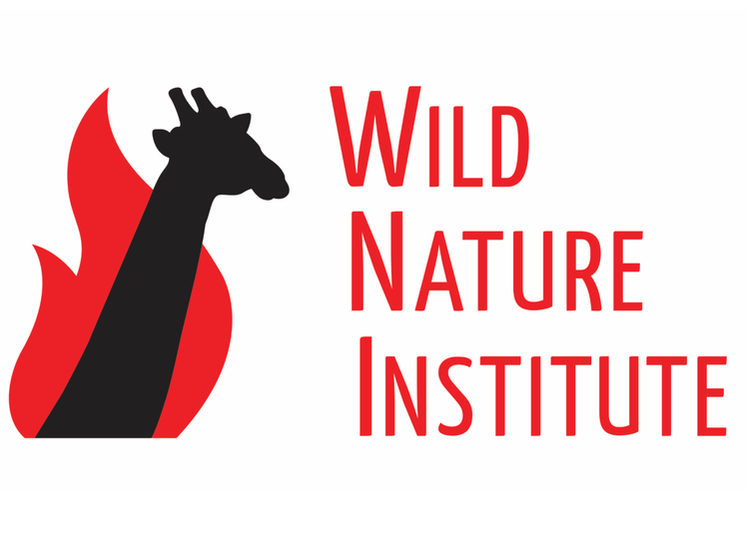 Masai giraffe and eastern white-bearded wildebeest in the Tarangire Ecosystem, Tanzania Masai giraffe and eastern white-bearded wildebeest in the Tarangire Ecosystem, Tanzania
ARUSHA, Tanzania, October 25, 2016 – Animal migrations are among the world’s most awe-inspiring natural phenomena. This complex behavior includes repeated, long-distance, seasonal movements between breeding and non-breeding sites. Unfortunately, animal migrations are an increasingly endangered phenomenon as migratory animals face the ubiquitous threats of habitat destruction and overexploitation, and the particular problem of human-created barriers. One of the best-known animal migrations is the great migration of wildebeests between Tanzania’s Serengeti plains and Kenya’s Masai Mara. Of the dozens of wildebeest migrations that existed in Africa in the 1900s less than a handful remain, and all but the Serengeti-Mara are endangered. The Tarangire wildebeest migration was the focus of a new study that measured how the seasonal presence of wildebeests in different parts of their migratory range influenced survival of resident giraffes, which do not migrate. The study, published this week in the journal Ecology and Evolution, was conducted by an international team of scientists from the USA and Tanzania. Dr. Derek Lee, of the Wild Nature Institute and lead author of the study, said, “The seasonal presence of thousands of migratory wildebeests diluted local lion predation and increased giraffe calf survival, with significant effects on giraffe population dynamics. If wildebeest populations in Tarangire continue to decline as a result of disrupted migration pathways outside Tarangire National Park and poaching for bushmeat, then giraffe populations will also be negatively impacted.” Giraffes are an iconic African species, but their numbers have dropped precipitously in recent decades and they are the latest African megaherbivore, along with rhinoceros and elephants, to become a species of conservation concern. Dr. Anne Dagg, a prominent pioneer of giraffe research and conservation said, “There are only about 100,000 giraffes living wild in Africa. We must act now to ensure that these magnificent creatures never become extinct.” The decline of the world’s animal migrations is a major environmental and economic problem, given the important ecosystem services and tourism revenues these species provide. Migrating species access high-quality food resources unavailable to non-migrants, thus migratory populations become ten times greater in number compared to residents. At those extreme numbers, migratory wildebeests exert large positive effects across the ecosystem. Dr. Tom Morrison, an expert in wildebeest migration ecology at the University of Glasgow, said, “Wildebeests drive most aspects of the ecosystem, from determining tree cover to regulating soil carbon to sustaining predators. Their loss would be catastrophic.” Tarangire National Park earns tens of millions of dollars each year for Tanzania’s tourism economy, which is the country’s largest dollar-earning economic sector. The Serengeti migration is protected in its entirety, but the Tarangire migration is mostly on unprotected lands and migratory wildebeests must leave the park to find nutritious grass growing on fertile soils for reproduction. The severing of Tarangire’s migratory route would result in population crashes because soils and grasses inside the park are infertile and can only support small numbers of wildebeests. The new study suggest other wildlife, such as giraffes, would also be negatively affected by the loss of the wildebeest migration. The Tarangire ecosystem was historically used as rangelands for livestock-keeping people like the Masai, but farming people from other parts of Tanzania have arrived recently and converted large swathes of former rangeland into farms. Proposals exist to stop wildebeest habitat from being converted to agriculture and to reduce driving speeds along two paved roads that intersect the Tarangire wildebeest migration route. Dr. Lee said, “Conserving the Tarangire wildebeest migration will have positive ripple effects throughout the ecosystem, benefitting many threatened wildlife species like giraffes, and sustaining Tanzania’s tourism economy.” Wildebeest deaths from vehicles have not been counted, but in the past year, two pregnant giraffes were killed by speeding vehicles in the wildebeest migratory pathway. Managing the dry, marginal agricultural lands outside the park for the benefit of livestock-keeping people while keeping movement pathways open for wildlife would sustainably conserve the ecology, economy, and culture of northern Tanzania’s rangelands in the Tarangire ecosystem.
0 Comments
Your comment will be posted after it is approved.
Leave a Reply. |
Science News and Updates From the Field from Wild Nature Institute.
All Photos on This Blog are Available as Frame-worthy Prints to Thank Our Generous Donors.
Email Us for Details of this Offer. Archives
July 2024
|
|
Mailing Address:
Wild Nature Institute PO Box 44 Weaverville, NC 28787 Phone: +1 415 763 0348 Email: [email protected] |
|


 RSS Feed
RSS Feed
